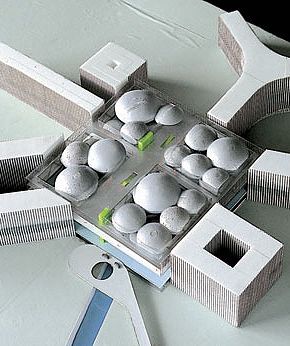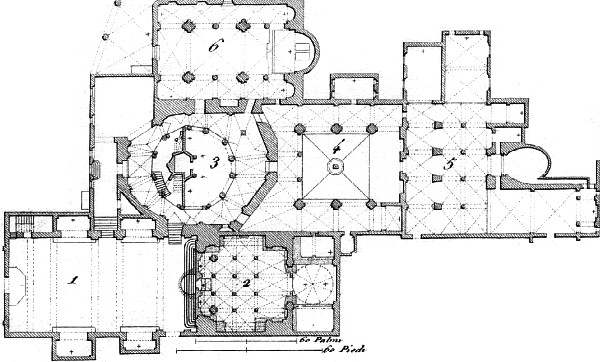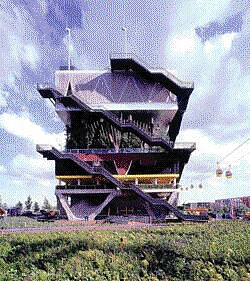
2002 NATO Headquarters
2003.09.28 16:55
Re: Quite a reenactor!!!
I see the possibility of Seroux's work being enhanced via HTML in that throughout the text that accompanies each engraved plate there are references from an image or set of images on one engraved plate to other images on another or even several other engraved plates--hyperlinkage could be of benefit here. Moreover, I found that aspects/details of many buildings are distributed throughout the whole set of engravings. For example, a plan of a church may be displayed with other church plans of the same era, but a column from this church is depicted on another engraving that presents a vast variety of columns all arranged in chronological order. The same disbursement goes for details of arches, walls, and domes. In redoing the work utilizing HTML, not only can the work be recreated as originally published albeit with hyperlinks, but whole new 'plates' of drawings can be composed where (for the first time) all aspects of an individual building are displayed together, and these new displays can then be further worked via hyperlinks into the historical outline Seroux already established. I'd also like to add some new text to the Histoire.
Interestingly enough, the drawings (by many top-notch French architectural apprentices that Seroux hired) on which the engravings are based are now at the Vatican Library. And, according to Vidler, the original drawings far surpass the engraved drawings, mostly because the engraved drawings are much reduced from the original size.
My favorite 'discovery' to come out of this exercise so far is learning about the Basilica of St. Stefano, Bologna, thirteenth century, a religious compound where the Court of Pilate and the Church of the Holy Sepulcher, Jerusalem were/are specifically reenacted.

| |
2003.10.27 Crack Scam
2004.07.17 Good-Bye House
2005.03.21 Mosque Q
2005.03.22 10:26
church and synagogue
Since learning that Le Corbusier's St. Pierre at Firminy-Vert is again under construction and slated for completion 2006, I had been thinking about the 3D CAD model of this building design in Quondam's collection. I was reminded of (a set of 1998 Quondam web pages that exhibited) how the plan of St. Pierre fit very nicely into the sanctuary of Louis Kahn's Hurva Synagogue.
Yesterday, I placed the model of St. Pierre inside the model of Hurva Synagogue, and started rendering images of the results. I thought I was really just playing until I thought about the architectural implications of designing a Roman Catholic Church within a Jewish Synagogue. Would such an architecture speak to how Christianity is more or less wrapped in Judaism? And, given the nature of the Hurva design, there is every evocation of St. Pierre being "wrapped within ruins."
2005.03.22 12:06
my first 3D CAD model of a Mosque
You know that St. Pierre/Hurva Synagogue model I just wrote about generating yesterday? Well, you know what? It looks just like a Mosque!
2005.04.06 Sober House 2
2005.05.06 11:39
modernity/post-modernity
In other words:
What is the value of architecture if its primary concern is onomatopoeia?
And what value does any architecture have without hyperbole?
Personally, I find value in appositional architecture.
2005.05.17 18:51
hotrod architecture
I never thought of appositional architecture as a reenactment of 'hotrodding' before...
2005.09.13 13:39
"design" vs. "styling"
The muddy water clears up real quick for me as soon as I add 'ephemerality' to the mix.
It even helps in these muddy waters.

| |
2005.09.13 17:05
"design" vs. "styling"
I'm more interested in the self evidence of it all. For example, I like the design of MVRDV's Dutch Pavilion, especially as presented in drawings and within the continuum of their oeuvre. I didn't so much like the Pavilion as built (at least from the images I've seen). And now there is no denying that the Dutch Pavilion is leftover trash, architecture that might be saved or that might be demolished. Overall (so far), the good reality of the design is outweighed by the bad reality of the design.
Is the Dutch Pavilion also stylized? It seems to be so in that a lot of it was also high-maintenance.
Will the design of the Dutch Pavilion ever be a true paradigm for future architecture? I'll say definitely maybe.
2005.12.30 Genetic Engineering 001
2005.12.30 Genetic Engineering 003
2005.12.30 Genetic Engineering 004
2006.02.24 Husker Du Haus
2006.02.24 Husker Du Haus, too
2006.02.25 Blob or Box
2006.02.25 Helena Fuming
2006.02.25 Genetic Engineering 005
2006.02.25 War Spoils
2006.06.09 House of Shadows Bye
2006.06.09 Stoner Food Resturant
2006.06.21 Ephemeral Conceptual Art 001
2006.07.21 Parrish Art Museum
2006.08.03 The Art of Advertising
2007.03.09 18:28
...and speaking of random tangents
I had no idea Herzog & de Meuron were working on a design for the Parrish Art Museum. ...the plan also reminds me of random tangents.
2007.03.09 22:02
...and speaking of random tangents
The four architects had decided to achieve an effect of harmony and therefore not to use any historical style in its pure form. Peter Keating designed the white marble semi-Doric portico that rose over the main entrance, and the Venetian balconies for which new doors were cut. John Erik Snyte designed the small semi-Gothic spite surmounted by a cross, and the bandcourses of stylized acanthus leaves which were cut into the limestone of the walls. Gordon L. Prescott designed the semi-renaissance cornice, and the glass-enclosed terrace projecting from the third floor. Gus Webb designed a cubistic ornament to frame the original windows, and the modern neon sign up on the roof, which read: "The Hopton Stoddard Home for Subnormal Children."
"Comes the revolution," said Gus Webb, looking at the completed structure, "and every kid in the country will have a home like that!"
The original shape of the building remained discernable. It was not like a corpse whose fragments had been mercifully scattered; it was like a corpse hacked to pieces and reassembled.
--Ayn Rand, The Fountainhead (1943), pp. 385-6.
Is anyone reading Frascari's Monsters of Architecture these days?
Are monsters merely crazy, mixed-up reenactments?
| |
2007.05.03 Hurva Dormitories
2007.05.28 Gooding Trice House
2007.07.08 12:52
8 July
Maybe the twin couples are going to publish a new journal on architecture entitled Appositions.

Were ideology and style once Siamese twins?
2007.07.13
next cad work at Quondam
With regard to Appositions, start creating a whole bunch of plan appositions, really just do them...
...also create interesting drawing compositions in the process. And I want the notion of scale comparisons to be evident as well. This might turn out interesting, especially with inclusion of the mesh and surface models (in plan).
And generate a whole bunch of new plans via creating perspectives of the plans. Since none of this work actually means anything, I could also be as experimental, playful and even sarcastic as possible...
2007.07.17
Le Corbusier plans, etc.
In starting to do some cad apposition play tonight I found myself stifled by not knowing how to start. It seemed that the "right" plans were not at hand, and/or the scale of plans did not mix. In thinking about it now I should have just started with whatever was available and continued generating apposed plans one after another. As a result of not knowing what to do, I started to compile plans of Le Corbusier designs in the collection. I suppose I could start with apposing Corbusier plans, but I need to incorporate other (architect's) plans as well.
...the point of the appositions is to create whole new plans.
...utilize the cad data in a way that is original and/or unexpected and/or contrary to standard convention. First I should start with straight scale comparisons--via at least three plans--and from there begin the appositional compositions.
I was thinking that a 200 ft square quadrant could be the common denominator of all the scale appositional exercises, and then any exercise can easily relate/display with any other exercise.
|